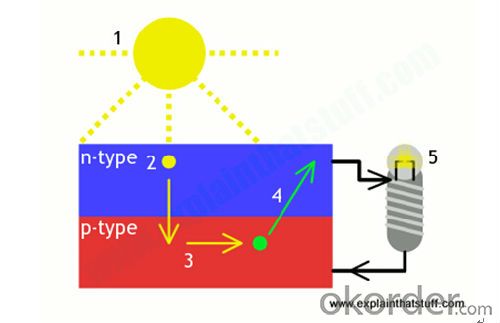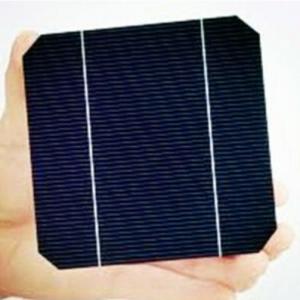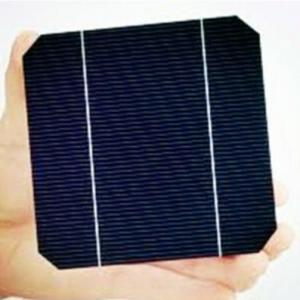Solar Cell for Solar Panel Monocrystalline and Polycrystalline 156
- Loading Port:
- China main port
- Payment Terms:
- TT or LC
- Min Order Qty:
- 100000 watt
- Supply Capability:
- 10000000 watt/month
OKorder Service Pledge
OKorder Financial Service
You Might Also Like
1. Structure of Solar Cell for Solar Panel Monocrystalline and Polycrystalline 156
A solar cell, or photovoltaic cell, is an electrical device that converts the energy of light directly into electricity by the photovoltaic effect, which
is a physical and chemical phenomenon.
It is a form of photoelectric cell, defined as a device whose electrical characteristics, such as current, voltage, or resistance, vary when exposed to light.
Solar cells are the building blocks of photovoltaic modules, otherwise known as solar panels.

2. Main Features of the Solar Cell for Solar Panel Monocrystalline and Polycrystalline 156
• 16.8%~18.25% high efficiency
• 100% checked quality
• SO9001/ISO14001/TUV/UL
• fast lead time
3. Solar Cell for Solar Panel Monocrystalline and Polycrystalline 156 Images


4. Solar Cell for Solar Panel Monocrystalline and Polycrystalline 156 Specification
poly 156 cell Electrical Characteristics( solar cell for solar panel ) | ||||||||||||
Efficiency(%) | 18 | 17.8 | 17.6 | 17.4 | 17.2 | 16.8 | 16.6 | 16.4 | 16.2 | 16 | 15.8 | 15.6 |
Pmpp(W) | 4.33 | 4.29 | 4.24 | 4.19 | 4.14 | 4.09 | 4.04 | 3.99 | 3.94 | 3.9 | 3.86 | 3.82 |
Umpp(V) | 0.53 | 0.527 | 0.524 | 0.521 | 0.518 | 0.516 | 0.514 | 0.511 | 0.509 | 0.506 | 0.503 | 0.501 |
Impp(A) | 8.159 | 8.126 | 8.081 | 8.035 | 7.99 | 7.938 | 7.876 | 7.813 | 7.754 | 7.698 | 7.642 | 7.586 |
Uoc(V) | 0.633 | 0.631 | 0.628 | 0.625 | 0.623 | 0.62 | 0.618 | 0.617 | 0.615 | 0.613 | 0.611 | 0.609 |
Isc(A) | 8.709 | 8.677 | 8.629 | 8.578 | 8.531 | 8.478 | 8.419 | 8.356 | 8.289 | 8.22 | 8.151 | 8.083 |
mono 156 Electrical Characteristics( solar cell for solar panel ) | ||||||||||||
Efficiency(%) | 20 | 19.2 | 19 | 18.8 | 18.6 | 18.4 | 18.2 | 18 | 17.8 | 17.6 | 17.4 | 17.2 |
Pmpp(W) | 4.59 | 4.54 | 4.49 | 4.45 | 4.4 | 4.35 | 4.3 | 4.26 | 4.21 | 4.16 | 4.11 | 4.08 |
Umpp(V) | 0.541 | 0.54 | 0.538 | 0.535 | 0.533 | 0.53 | 0.527 | 0.523 | 0.519 | 0.518 | 0.516 | 0.514 |
Impp(A) | 8.484 | 8.407 | 8.346 | 8.318 | 8.255 | 8.208 | 8.159 | 8.145 | 8.112 | 8.031 | 7.95 | 7.869 |
Uoc(V) | 0.64 | 0.639 | 0.638 | 0.637 | 0.636 | 0.634 | 0.632 | 0.631 | 0.63 | 0.629 | 0.628 | 0.627 |
Isc(A) | 8.972 | 8.959 | 8.936 | 8.912 | 8.875 | 8.83 | 8.805 | 8.787 | 8.775 | 8.695 | 8.615 | 8.535 |
5. FAQ of Solar Cell for Solar Panel Monocrystalline and Polycrystalline 156
Q1. How long can we receive the product after purchase?
A1.In the purchase of product within three working days, We will arrange the factory delivery as soon as possible. The pecific time of
receiving is related to the state and position of customers
Q2. Can we visit your factory?
A2:Surely, I will arrange the trip basing on your business schedule.
Most Common Uses of Solar Cells
Perhaps the most popular use of solar energy is one that doesn't involve technology at all: drying wet things. People around the world depend upon the sun to dry everything from laundry to crops. It's an effective way to achieve a goal without relying upon electricity.
It may seem unusual, but solar power has become a popular way to provide power to lighting systems that activate after the sun goes down. From street lights to garden lamps, solar power provides the energy needed to illuminate the darkness late into the night. These lights contain batteries that charge during the day as sunlight hits the solar cells. At night, a photoresistor detects the absence of light and a circuit board triggers the batteries to discharge and provide power to LED lights, which are efficient and bright.
Solar cells are very useful in powering space vehicles such as satellites and telescopes (e.g. Hubble). They provide a very economical and reliable way of powering objects which would otherwise need expensive and cumbersome fuel sources.
The above design for a solar cell array in space features many inflatable, fresnel reflectors which focus the Sun's light on small arrays of high efficiency cells.
The international space station is also another good example of solar cells being used in space. When it is finished, the station will have the most powerful solar array in space. Four sets of gold coloured wings (each one being 72 metres long and larger than the space station itself) will contain 250,000 solar cells and the whole array will be able to power a small neighbourhood. Some of the energy will be used immediately, such as in life support machines while some will be stored in batteries for when the station is not in use.
Solar cells are also being used to power the rovers which will be examining the surface of Mars in early 2004.
- Q:Are solar cells environmentally friendly?
- Yes, solar cells are environmentally friendly. They produce clean and renewable energy by converting sunlight into electricity without emitting harmful greenhouse gases or pollutants. Additionally, solar cells have a long lifespan and can be recycled at the end of their life, minimizing their environmental impact.
- Q:How does the efficiency of solar cells vary with different materials?
- The efficiency of solar cells varies with different materials due to their varying properties and characteristics. Some materials, like silicon, have high efficiency as they have a suitable bandgap for absorbing sunlight and converting it into electricity. Other materials, such as thin-film materials like cadmium telluride or perovskites, may have lower efficiency but offer advantages like flexibility or lower production costs. Overall, the efficiency of solar cells is highly dependent on the specific material used and its ability to convert sunlight into electrical energy effectively.
- Q:Can solar cells be used to power air conditioning systems?
- Yes, solar cells can be used to power air conditioning systems. However, the efficiency and capacity of the solar cells, as well as the size of the air conditioning system, need to be considered to ensure sufficient power supply.
- Q:Can solar cells be used in educational institutions?
- Yes, solar cells can be used in educational institutions. They can be used to generate clean and renewable energy, which can help reduce the institution's carbon footprint and energy costs. Additionally, solar cells can serve as an educational tool, allowing students to learn about sustainable energy sources and the importance of environmental conservation.
- Q:Can solar cells be used to power electronic devices?
- Yes, solar cells can be used to power electronic devices. Solar cells convert sunlight into electricity, which can be used to power a wide range of electronic devices such as calculators, smartphones, and even household appliances.
- Q:What is the impact of saltwater exposure on solar cell efficiency?
- Saltwater exposure can have a significant negative impact on solar cell efficiency. The saltwater can corrode the metal components of the solar cells, leading to a decrease in their performance and overall efficiency. Additionally, the saltwater can create a conductive pathway that can bypass the solar cells, resulting in a loss of electrical energy. Therefore, it is crucial to protect solar cells from saltwater exposure to maintain their efficiency and prolong their lifespan.
- Q:Can solar cells be used in remote sensing devices?
- Yes, solar cells can be used in remote sensing devices. Solar cells convert sunlight into electricity, which can power various sensors and data collection devices used in remote sensing applications. The use of solar cells ensures that these devices can operate independently and sustainably in remote locations without the need for external power sources.
- Q:What is the impact of bird collisions on solar cell performance?
- Bird collisions can have a negative impact on solar cell performance. When birds collide with solar panels, it can cause physical damage to the panels, leading to reduced efficiency and power output. Additionally, bird droppings and debris from collisions can accumulate on the surface of the panels, further hindering their performance. Implementing preventive measures, such as bird deterrents or mesh covers, can help mitigate the impact of bird collisions on solar cell performance.
- Q:What is the payback period for installing solar cells?
- The payback period for installing solar cells varies depending on several factors such as the initial cost of the installation, the amount of energy generated, and the cost of electricity. On average, it typically takes between 5 to 10 years for solar cells to recoup their initial investment through energy savings.
- Q:What information can I get from the Internet about the solar cell modules? Such as what it is? How it is made?
- Here is what I can found online about the solar cell module for your information: A bulk silicon PV module consists of multiple individual solar cells connected, nearly always in series, to increase the power and voltage above that from a single solar cell. The voltage of a PV module is usually chosen to be compatible with a 12V battery. An individual silicon solar cell has a voltage of just under 0.6V under 25 °C and AM1.5 illumination.
1. Manufacturer Overview |
|
|---|---|
| Location | |
| Year Established | |
| Annual Output Value | |
| Main Markets | |
| Company Certifications | |
2. Manufacturer Certificates |
|
|---|---|
| a) Certification Name | |
| Range | |
| Reference | |
| Validity Period | |
3. Manufacturer Capability |
|
|---|---|
| a)Trade Capacity | |
| Nearest Port | |
| Export Percentage | |
| No.of Employees in Trade Department | |
| Language Spoken: | |
| b)Factory Information | |
| Factory Size: | |
| No. of Production Lines | |
| Contract Manufacturing | |
| Product Price Range | |
Send your message to us
Solar Cell for Solar Panel Monocrystalline and Polycrystalline 156
- Loading Port:
- China main port
- Payment Terms:
- TT or LC
- Min Order Qty:
- 100000 watt
- Supply Capability:
- 10000000 watt/month
OKorder Service Pledge
OKorder Financial Service
Similar products
New products
Hot products
Hot Searches
Related keywords































